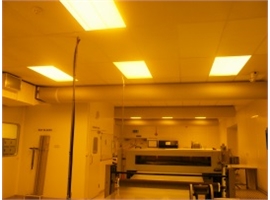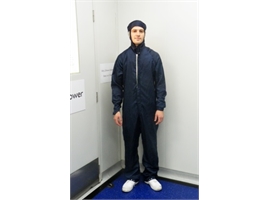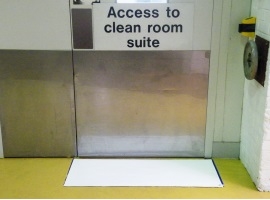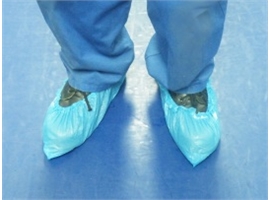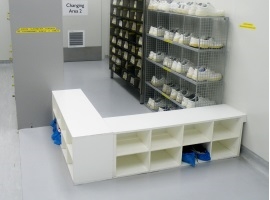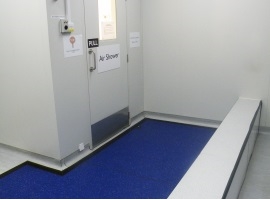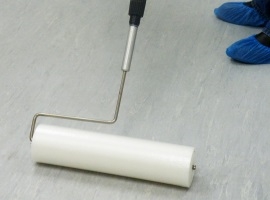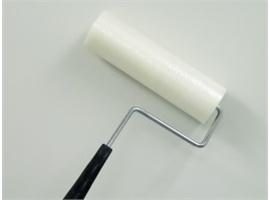How to Guide - Cleanroom working
Synopsis...
For the specialist screen printer there may come a time when clean working processes become essential to production improvements. In marketing terms, products manufactured in clean room environments are value added as they have fewer quality failures and are typically aimed at advanced technologies. Your investment could soon turn into greater profit.
Building and operating a clean room as a fully fledged working environment can be daunting and expensive. Diligence is required at all stages of the planning process and you may find that instead of a full clean room you can operate under a simpler controlled environment. The difference between the two is in the number of the particles present. The choice between clean room and controlled environment impacts on cost, from the initial build to the running of the facilities. Controlled environments are easier to operate, requiring less stringent processes. It is vital to assess your needs thoroughly before identifying the correct solution. Our experience spans all aspects of clean manufacturing and this article aims to give you a greater understanding of key clean room processes. Some of the generic suggestions are fairly inexpensive to execute, others may require advanced planning and highly complex engineering. The difference between essential and desirable can determine the success of your operation.
A single particle can spoil the result
A clean room is a controlled environment where levels of particulate and contamination of all kinds are minimized. Typically every cubic metre of unfiltered ‘clean’ air, such as an office environment, could contain around 35 million particles in the size of 0.5µm which is reduced to only 350 thousand in an ISO 7 cleanroom. ISO 7 equates to a Class 10000 (i.e. 10000 particles per cubic foot).
People and air
Clean air circulation is at the heart of clean room technology and the first step in achieving a clean room environment concerns air quality. Air is highly filtered using HEPA (High Efficiency Particulate Air) filtration and continuously flushed. HEPA filters can prevent over 99.97% particles greater than 0.3 microns in size from entering a clean room.
Air flow is of paramount importance; the more gently the air is introduced into the environment the less likelihood of air turbulence wafting particles around. In addition, positive air pressure in the room prevents the ingress of dirty air. Finally, avoiding air flow near critical areas is always best.
Introducing clean air, however, is only part of the process. The greatest source of contamination is people. The human body, by simply walking around, can generate 5 to 10 million skin, hair, dirt and clothing particles every minute but ten times less when sitting or standing. For this reason it is essential to keep personnel movement in a clean room environment to a minimum.
This picture shows air socks to diffuse the air flow from the HEPA filtered air conditioning
Clean room garments, using tightly woven man made fabrics, have been developed to inhibit contamination caused by people. Everyone accessing a clean room should wear appropriate garments including hats, hoods and overshoes.
Due care and attention must be paid to the changing room processes, separating dirty from clean clothing areas and using dressing procedures aimed at preventing the release of particles e.g. tucking hoods into garments. Clean room garments should be laundered regularly, at least weekly and dedicated footwear used. The running costs of kitting out staff vary depending on the requirement, with a full set costing approximately £5 per day per worker.
Tack mats are used as the first step in decontamination
The second step is to use over shoes to cover footwear
A step over bench is used when changing from outdoor wear to clean room footwear
A final step over bench is used before entering the air shower
Preventing contamination once clean air is introduced becomes one of the hardest tasks. People are a critical aspect of the clean cycle, but attention should be paid to three further elements: facilities, tools and materials.
From paint to pens
To minimise contamination due care should be paid to all the facilities (walls, surfaces, and furnishing). Stainless steel, plastics or other non shedding materials are widely used, but even these must be checked regularly for scuff and scratches and discarded when showing signs of wear.
Shelves should be constructed with open grate stainless steel to minimize air turbulence and surface area. They should be kept away from critical process areas to reduce the formation of air vortices. Paint should also be scratch and chip resistant such as two-part polyurethane or epoxy based paint. Materials and boxes that need to be introduced into the clean room need to be non-fibre shedding. Paper-like documents or books, should be introduced only if contained in a glove box with a transparent lid for easy viewing.
Constructing and managing a clean room requires continuous assessment and attention to what might seem even the most trivial detail. For example, even the humble retractable ballpoint should be changed for a single piece pen, as clicking may generate particles. Pencils cause graphite contamination, and, along with erasers, must be excluded.
Once the facilities have been assessed it is time to look at the materials used, tools and manufacturing operations.
Packaging may present one of the biggest contamination hazards and may have to be cleaned before introduced into the clean room. Paper and cardboard products should never be introduced inside a clean room, favouring nylon, polyethylene, polyethylene and nickel/Mylar laminate. Should compressed air be required, specialist oil free air systems are available in the market. These can be fitted with a variety of accessories to furnish air to the required standards.
Fluids like solvents should be filtered before use and contain little or no soluble residue. Every clean room should have its own dedicated tool set, eliminating the need for repeated cleaning to perform routine jobs. Emergency materials such as spill mats need to be assessed and used only as a last resort. When essential maintenance is required, processes need to be looked at and HEPA filtered extraction provided if tools such as files or drills are in use.
The task of initial implementation may appear daunting as it requires studying every aspect of your manufacturing process, but if the correct procedures are in place it will become routine.
What stays out of your clean room
By now the list of prohibited materials should be obvious; basically anything likely to shed particles. This includes aerosols, food, drinks and even mobile phones. In simple terms understanding this basic principle could also help you if you wanted to introduce a controlled environment to your existing operation, a first step down the road to full clean rooms.
Aside from anything abrasive or powders, some aerosols and chemicals which form particles should also be prevented from contaminating a clean room.
In very clean environments many everyday items such as food or newspapers may even have to be banned from changing areas; only filtered water should be consumed inside a clean room and only in allocated spaces.
Lastly, designated communication devices should be used and never anything that may be kept on a person as this might require the unzipping of protective overalls, introducing potential contaminants.
In short, nothing other than the approved materials must be used or taken into these protected production areas.
Comings and goings
Frequent and fast movement should be avoided. Doors and windows must never be left open. A two-door system, preferably with the addition of an air shower in an air lock should be the preferred entry option. Sticky mats should be used in all outer entry points to minimize dirt ingress.
Materials brought into the clean area should always be removed from any fibrous packaging and cleaned with HEPA filtered vacuum, a tacky roller or wipe before being taken in.
Clean rooms remain as such not only thanks to the practices we have just highlighted, but also because they are cleaned regularly. There is no ISO standard for cleaning frequency, as processes will vary greatly depending on the manufacturing operation, but the purpose is to keep the area continuously in check and every single procedure should have a well documented supervised routine. Specialist cleaning equipment needs to be used (tacky wipes, mops, buckets, etc.) and if vacuuming is needed this can be done only using HEPA filtered vacuum with tacky rollers always at the ready.
Keeping a clean room clean requires some specialist cleaning tools and products.
Keeping a clean room tidy isn’t just a good general practice but an essential feature making the cleaning operation easier and more effective, such as collecting waste materials frequently.
The presence of static, produced through separation, friction or induction, causes more dust to be attracted to surfaces; even the simple act of removing a sheet of film from a stack could produce static by separation and friction. Therefore, in clean rooms the use of anti-static measures, like earthing straps, anti-static guns and blowers is required.
Advanced 21st century operations
Running high standard clean room operations isn’t for the faint hearted and it is certainly far easier to introduce these practices where there are already disciplined and well documented manufacturing processes in place. For some organisations the step into clean room operations can be relatively painless; for others it may require a complete overhaul of all their procedures. The potential initial cost can be substantial and should only be justified after careful consideration of possible returns.
What is certain is that 21st century manufacturing will continue to evolve, becoming increasingly more complex and demanding. The levels of efficiency and competence that are required in running clean rooms are the ultimate goal in advanced manufacturing, with inherent gains across the entire spectrum of all your operations.
A clean room, or at least a controlled cleanliness environment may simply mean the difference between profit and loss. It may also give you the competitive edge against your competitors.
